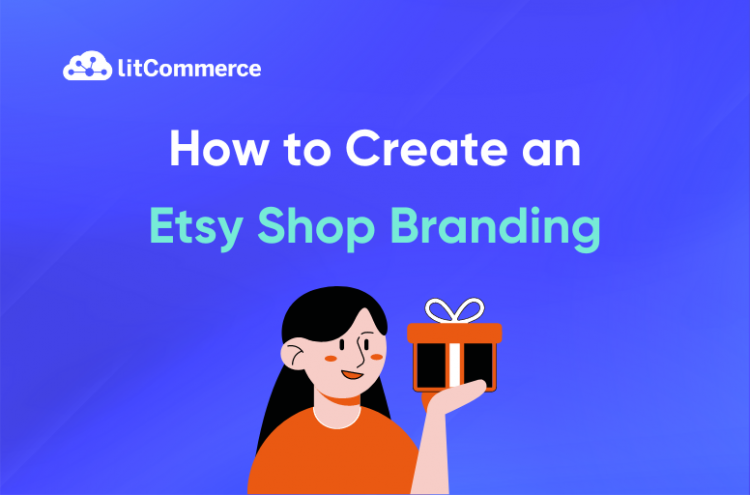Etsy is a top marketplace for selling products for handmade and crafting items. This marketplace offers a unique opportunity for independent creators and small businesses to showcase their products and reach a wider audience. However, standing out and gaining a strong Etsy shop branding can be challenging, with over 4 million active sellers on this best-selling platform.
Building a strong brand on Etsy is essential for success as it helps sellers differentiate themselves, build trust, and get more sales on Etsy.
In this guide, we’ll discuss the key elements of Etsy shop branding to help you create a powerful brand that resonates with customers. Below are 4 main points we’ll go through:
- Define your brand
- Optimize product presentation
- Offer excellent customer experience
- Market your brand
So, let’s dive in and unlock the potential of Etsy branding to elevate your shop, attract more customers, and achieve long-term success in the vibrant Etsy marketplace.
Understanding Your Etsy Shop Branding Identity
For those who start selling on Etsy, comprehending the essence of their brand identity assumes significant importance. You, then, may wonder: Is selling on Etsy worth it? This is where Etsy shop branding comes into play. This is because it enables them to advertise their merchandise efficiently and carve a niche for themselves in a fiercely competitive market. In this segment, we will guide you through the steps involved in defining your Etsy brand.
Define your target audience
Defining your target audience entails identifying the specific individuals who are most inclined to show interest in your products. By comprehensively understanding this group, you can customize your Etsy shop branding and marketing endeavors to appeal to them effectively.
To delineate your target audience, consider factors such as age, gender, location, interests, and income levels. Reflect on the issues your products address and the desires they fulfill, as this will aid in pinpointing the appropriate customer segments to focus on. Conducting market research, studying competitor shops, and actively engaging with potential customers through social media or surveys can also yield valuable insights into your target audience.

Identify your unique selling proposition
Your unique selling proposition (USP) represents the remarkable attribute or characteristic that distinguishes your products from those of your competitors. It serves as the compelling reason why customers should select your Etsy shop over others. To identify your USP, consider elements such as:
- Product design
- Craftsmanship
- Materials utilized
- Narrative accompanying your creations
By precisely determining your USP, you can concentrate your branding endeavors on showcasing the aspects that genuinely make your shop distinct and enticing to your intended customers.
How to Create an Impressive Etsy Shop Branding?
Building impressive branding for Etsy requires careful planning, creative execution, and strategic investment. While it’s true that establishing a strong brand on Etsy may involve some costs, the long-term benefits make it a worthwhile endeavor. If you want to learn about all the fundamental fees needed for Etsy sellers, check out the article about how much it costs to start an Etsy shop.
In this guide, we will explore the essential steps and considerations to help you build an exceptional Etsy brand.
#1. Define your brand
1. Brand name
First, when defining your Etsy shop branding, crafting a compelling name is vital as it shapes potential customers’ initial impressions and influences their perception of your business. Follow these steps to select the perfect name:
- Brainstorm ideas: Engage in a creative process to generate a diverse range of potential Etsy shop name ideas. Consider descriptors that reflect your products, words that evoke emotions, playful elements, or personal connections. Explore foreign languages for additional inspiration.
- Verify availability: It is crucial to confirm that your desired name is available on Etsy and other platforms. Conduct thorough searches to avoid any confusion with existing businesses and secure brand names for future marketing endeavors.
- Enhance memorability and ease of spelling: Opt for an easily remembered and spelled name. Avoid lengthy or complex names that may hinder customers’ ability to find and recall your shop effortlessly.
2. Brand story and values
Besides your brand name, crafting a compelling brand story and defining your values are crucial steps in developing a strong Etsy branding strategy. Here’s how you can create an impactful brand story and establish your brand values:
Craft your brand story: Your Etsy shop branding story is the narrative that conveys the essence of your business and connects with your target audience. Consider the following elements when crafting your story:
- Origins: Share the inspiration behind starting your Etsy shop. Discuss what motivated you to create your products and how your journey led you to where you are today.
- Passion and mission: Express your passion for your craft and the mission that drives your business. Explain how your products make a difference or value customers’ lives.
- Unique selling point: Highlight what sets your products apart from others in the market. Emphasize any special features, techniques, or materials that make your creations unique.

Define your brand values: Brand values represent the principles and beliefs that guide your business and resonate with your target audience. Consider the following steps:
- Identify your core values: Reflect on what matters most to you as a business owner. Are you committed to sustainability, quality, authenticity, or community engagement? Identify the values that align with your brand’s purpose.
- Connect with your audience: Research your target audience and understand their preferences. Ensure that your brand values resonate with them and address their needs and aspirations.
- Communicate your values: Clearly articulate your brand values in your shop description, product listings, and marketing materials. Show how you embody these values in your business practices and decision-making.
3. Visual identity
Furthermore, developing a strong visual identity is essential for creating a cohesive and appealing brand on Etsy. Here are steps to guide you in selecting appropriate colors, fonts, and graphics, as well as designing an appealing logo, banners, and storefront:
1 – Choose the Etsy shop branding color
Select colors that align with your brand personality and evoke the desired emotions in your target audience. Consider the following factors:
- Color psychology: Research the meanings and associations of different colors to ensure they resonate with your Etsy brand values and the emotions you want to evoke.
- Consistency: Choose a primary color palette of 2-4 colors that will be consistently used throughout your branding materials.
2 – Select fonts that complement your brand
Typography plays a significant role in establishing the tone and personality of your brand. Consider the following guidelines:
- Readability: Ensure your chosen fonts are legible and easily read across different devices and sizes.
- Brand personality: Select fonts that align with your Etsy branding identity. For example, elegant and script fonts convey sophistication, while bold and modern fonts represent a more contemporary style.
3 – Design an appealing Etsy logo
Your logo visually represents your brand and serves as a recognizable symbol. Consider the following tips:
- Simplicity: Keep your Etsy branding logo design clean and uncluttered for better recognition and versatility.
- Brand essence: Reflect your brand values, personality, and unique selling proposition in your logo design.
- Scalability: Design an Etsy logo that you can resize without losing clarity and impact.
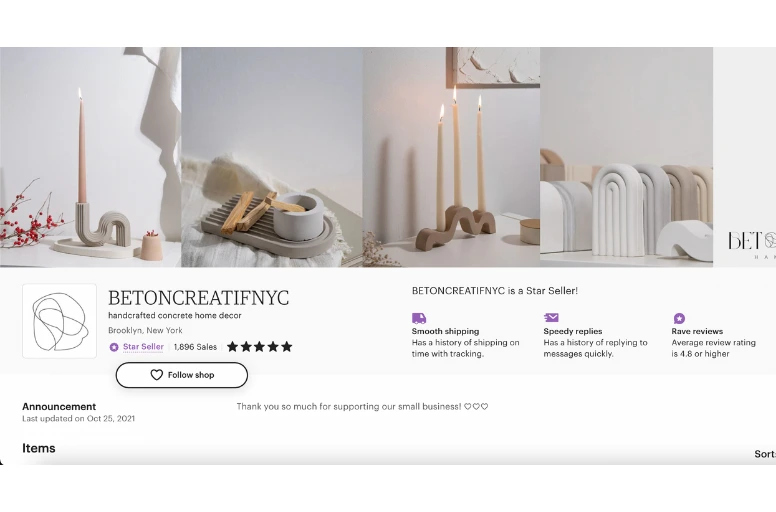
4 – Create an eye-catching Etsy banner and storefront
Your storefront is the virtual representation of your brand on Etsy. Consider the following:
- Consistent branding: Ensure that your banners and storefront design elements align with your chosen colors, fonts, and logo.
- High-quality visuals: Use professional product photos and compelling graphics to design banners for your shop that showcase your products effectively. The recommended Etsy banner size is 1200 pixels wide by 300 pixels tall.
- Clear and organized layout: Arrange your storefront in a way that is easy to navigate, with clear sections and visually appealing product displays.
To enhance your shop’s branding, check out our guide on How to Make An Etsy Shop Banner to Attract Customers in 2025.
#2. Optimize product presentation
To create a compelling and professional product presentation to get a huge impact on Etsy shop branding, focus on two key elements: product photography and product descriptions. Let’s explore each of these in detail:
1. Product photography
- Use high-quality images: Invest in a good camera or hire a professional photographer to capture high-resolution images of your products. Clear and sharp images will attract potential customers and showcase your items in the best light.
- Consistent background: Maintain a consistent background for your product photos to create a cohesive look across your shop. A clean and neutral background keeps the focus on the item itself.
- Proper lighting: Ensure your products are well-lit to showcase their details accurately. Natural light or diffused artificial lighting can help eliminate harsh shadows and enhance the overall quality of your photos.
- Show multiple angles: Include images that showcase your product from different angles, providing potential buyers with a comprehensive view. This helps them make informed decisions and increases their confidence in purchasing.
- Lifestyle or context shots: Consider including lifestyle or context shots that depict your product in use or styled in an appealing setting. This can help customers visualize how the item can fit into their lives.

2. Product descriptions
- Clear and concise: Write clear and concise product descriptions that accurately describe your item. Highlight its unique features, dimensions, materials used, and any other relevant details.
- Use keywords: Incorporate relevant keywords in your product descriptions to optimize them for Etsy marketing and SEO. Consider what potential buyers might search for when looking at similar items.
- Highlight benefits and value: Explain how your product benefits the customer or solves a problem they may have. Focus on the value it provides and why it’s worth purchasing.
- Tell a story: Share the story behind your product or the inspiration behind its creation. This helps create an emotional connection with your customers and adds a personal touch to your listings, hence, your customer will remember your Etsy shop branding story.
- Formatting and readability: Use bullet points, paragraphs, and headings to break up your product descriptions and make them easy to read. Customers can quickly scan the information and find what they’re looking for.
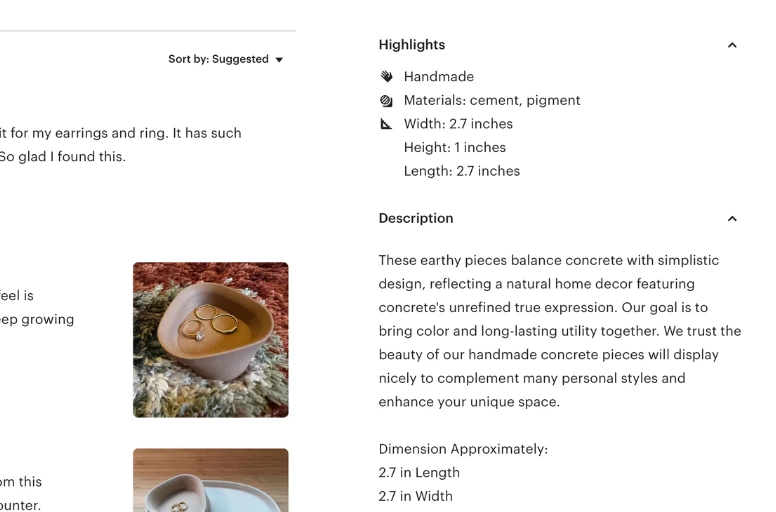
By optimizing your product presentation through photography and descriptions, you can effectively showcase your items, attract potential customers, and enhance your Etsy shop branding. Remember to maintain consistency and professionalism throughout your shop, ensuring that your product presentation aligns with your overall brand identity.
#3. Offer excellent customer experience
1. Packaging and unboxing
Creating a memorable and delightful unboxing experience is an effective way to enhance your Etsy shop branding. Consider the following strategies to optimize your packaging and unboxing process:
- Brand consistency: Ensure that your packaging aligns with your overall brand identity. Use consistent colors, logos, and design elements to create a cohesive and recognizable brand experience. This helps reinforce your brand image and makes your packages instantly recognizable.
- Quality materials: Choose high-quality packaging materials that not only protect your products but also add value and visual appeal. Consider using eco-friendly or sustainable packaging options to align with the values of environmentally conscious customers.
- Personalization: Add a personal touch to your packaging by including handwritten thank-you notes, customized stickers, or branded inserts. Personalization shows your appreciation for customers and creates a sense of connection, enhancing the overall experience.
- Surprise and delight: Consider adding small surprises or extras in your packages, such as samples, discount codes, or exclusive offers. These unexpected extras can delight customers, leaving a positive impression of your brand.
2. Customer service
Outstanding customer service is a key differentiator that can set your Etsy shop branding apart from competitors. Here are some strategies to provide exceptional customer service:
- Follow-up emails or messages: Send personalized follow-up messages to express gratitude for purchases and show appreciation for customer support. This fosters a positive connection and encourages repeat business.
- Responsiveness: Respond to customer inquiries, messages, and concerns promptly. Aim to reply to messages within a reasonable time frame, preferably within 24 hours, to show that you value and prioritize customer communication.
- Problem resolution: Handle customer issues and concerns with empathy and a proactive mindset. Listen actively, seek to understand the problem, and offer appropriate solutions or alternatives to resolve issues swiftly and satisfactorily.
- Professionalism: Maintain a professional and courteous demeanor in all customer interactions. Treat customers with respect, address them by name, and use polite and friendly language. A positive and friendly tone goes a long way in creating a pleasant customer experience.
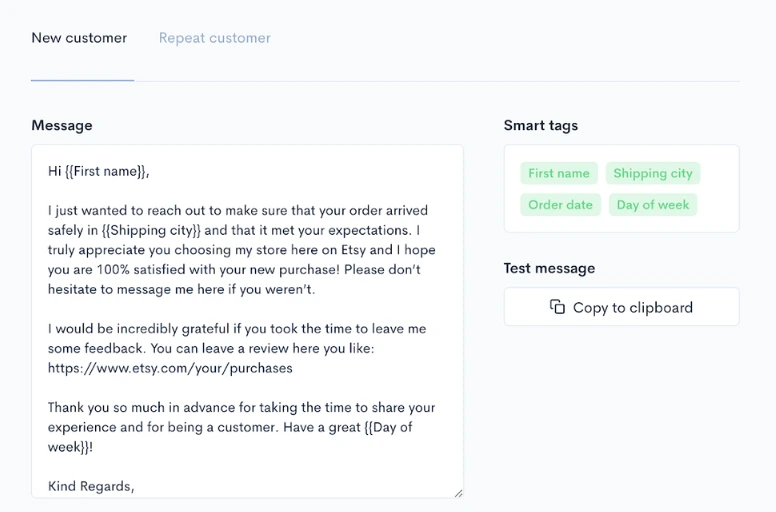
#4. Market your brand
Using social media and other marketing channels is one of the best Etsy marketing strategies to promote your Etsy shop branding and raise awareness. While there may be associated Etsy marketing fees, the potential benefits in terms of increased visibility and sales make it a worthwhile investment. Selecting the right platforms, creating a content strategy, and collaborating with influencers and Etsy sellers is key. This guide will delve into these aspects to help you enhance visibility and expand your customer base.
1. Social media strategy
Social media is a powerful Etsy marketing tool for promoting your Etsy brand and reaching a wider audience. Develop a strategic social media plan to market your brand effectively:
- Choose relevant platforms: Identify social media platforms that align with your target audience and product niche. Focus on platforms like Instagram, Facebook, Pinterest, or Twitter, where your potential customers are likely to be active. When choosing the appropriate platforms, consider several factors:
- User demographics: Analyze the user demographics of each platform to determine which ones are most popular among your target audience. For instance, Instagram and TikTok typically attract younger users, while Facebook and Pinterest have a broader age range.
- Content format: Consider the content that effectively showcases your products and brand narrative. Platforms such as Instagram, Pinterest, or YouTube are ideal for visually appealing products, whereas a blog or Twitter may be more suitable for written content.
- Time and resources: Evaluate the amount of time and resources you can allocate to managing your social media and marketing endeavors. Platforms like Instagram and TikTok often require more frequent content updates, whereas Pinterest and a blog allow for more evergreen content that can be managed at a sustainable pace.
- Consistent Etsy shop branding: Maintain a consistent brand presence across all your social media profiles. Use cohesive visuals, including your logo, colors, and imagery, to create a recognizable and cohesive brand identity.
- Engaging content: Create compelling and visually appealing content that showcases your products, tells your brand story, and resonates with your buyers. Include behind-the-scenes glimpses, product tutorials, and customer testimonials to build engagement and foster a community around your brand.
- Hashtag strategy: Utilize relevant hashtags to expand your reach and visibility. Research popular hashtags within your industry and incorporate them into your social media posts to increase discoverability and attract potential customers.
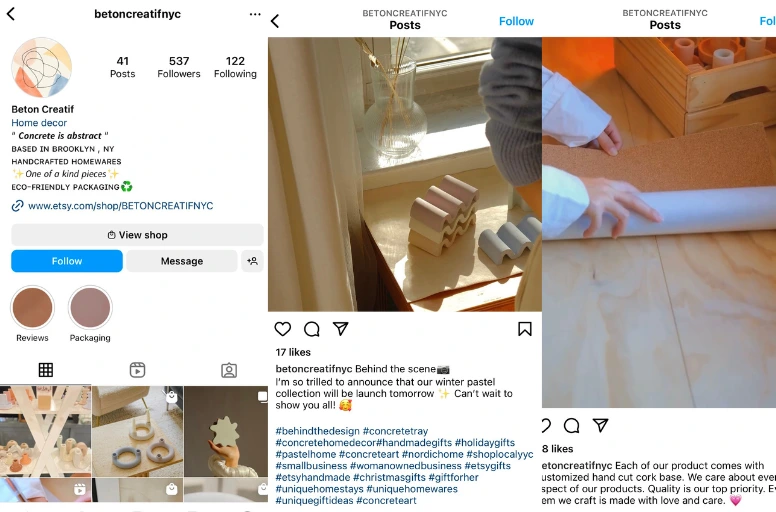
2. Collaborations and influencer marketing
When it comes to creating an Etsy shop branding, collaborating with influencers or other Etsy sellers can significantly boost your brand visibility and credibility. Consider the following strategies:
- Identify suitable collaborators: Look for influencers or other Etsy sellers who align with your brand values, target audience, and product niche. Research their reach, engagement, and authenticity to ensure a good fit for collaboration.
- Influencer campaigns: Partner with influencers to create sponsored content featuring your products. This can include product reviews, tutorials, or styled photoshoots that highlight your brand and drive traffic to your Etsy shop.
- Cross-promotions: Collaborate with other Etsy sellers or complementary brands for cross-promotional activities. This can include joint giveaways, sharing each other’s products on social media, or featuring each other in blog posts or newsletters to expand your reach to new audiences.
3. Email marketing
Lastly, email marketing is an effective tool to engage with your existing customer base and nurture relationships. Follow the steps below for successful email marketing and better enhance Etsy shop branding:
- Build a subscriber list: Encourage visitors to your Etsy shop to sign up for your email newsletter by offering incentives such as exclusive discounts, early access to new products, or valuable content. Use email capture forms or pop-ups on your website or Etsy shop to collect email addresses.
- Personalized and targeted campaigns: Segment your email list based on customer preferences, purchase history, or other relevant criteria. Create personalized email campaigns tailored to specific segments to provide relevant content and product recommendations.
By implementing a robust Etsy marketing strategy, you can effectively market your Etsy brand. These strategies contribute to building a strong brand presence, fostering customer loyalty, and ultimately growing your Etsy business.
Etsy Shop Branding: FAQs
- What is branding on Etsy?
Branding on Etsy is the process of creating a unique identity and image for your Etsy shop. It involves crafting a cohesive and memorable brand that sets you apart from competitors, communicates your values and offerings, and resonates with your target audience. Branding encompasses elements such as your shop name, logo, visual aesthetics, product packaging, customer experience, and brand messaging.
- How do I brand myself on Etsy?
To brand yourself on Etsy:
- Start by defining your brand identity.
- Create a compelling shop name and logo that align with your brand image.
- Develop a consistent visual style by using cohesive colors, fonts, and imagery.
- Pay attention to your product photography and descriptions to showcase your brand personality.
- Deliver excellent customer service, provide unique packaging experiences, and tell your brand story through your listings and shop policies.
- Employ social media platforms and email marketing and collaborate with influencers to effectively market your Etsy brand.
- How important is branding on Etsy?
Branding is crucial on Etsy as it helps you stand out in a saturated marketplace, build customer trust, and cultivate a loyal following. A strong brand creates recognition, differentiates you from competitors, and establishes an emotional connection with your audience. It sets the foundation for effective marketing, customer engagement, and long-term business success.
Confidence in Your Etsy Shop Branding
In conclusion, branding is an important aspect of any successful Etsy store. By implementing a cohesive branding strategy, you can communicate your values and personality to your customers, build trust and loyalty, and stand out in a crowded marketplace. Remember to consider all aspects of your brand, from your shop name and logo to your product packaging and customer service.
To enhance your eCommerce journey with valuable insights and expert advice, let’s explore our informative blog and join our supportive community. By doing so, you can access a wealth of resources and connect with like-minded individuals who can provide valuable eCommerce insights and support. If you have any further concerns, contact LitCommerce now for assistance.

